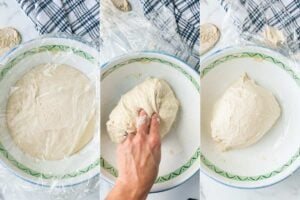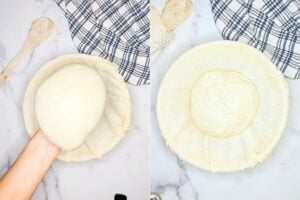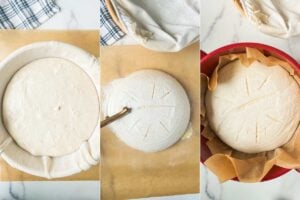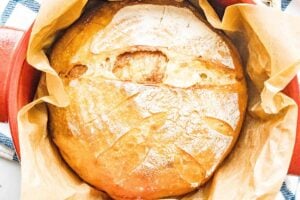Easy Artisan Sourdough Bread
An easy artisan style sourdough loaf with an open crumb and crisp crust. This recipe needs to be started more than 24 hours ahead of serving
Equipment
- Large mixing bowl
- Spatula
- Plastic Wrap
Ingredients
- 7 ounces bubbly, fed sourdough starter (¾ cup + 1 tablespoon)
- 15 ounces bread flour (3 cups)
- 9 ounces room temperature water (1 cup + 2 tablespoons)
- 1 teaspoon granulated sugar
- 1½ teaspoons salt
Instructions
- Mix and autolyze. Combine all ingredients except the salt in a large mixing bowl. Then, stir with a spoon or spatula to create a sticky dough. Cover with a damp tea towel or plastic wrap and rest for 30-60 minutes. (Autolyze: This rest period allows the flour to hydrate and begin developing gluten fully.)

- Knead in the salt. After the resting period, measure and add the salt to the dough. Gently knead on the counter (or in the bowl) until the salt is mixed in. Put the dough in a clean, lightly greased bowl. Cover and let it rest at warm room temperature (80-90 degrees) for 1 hour.

- Stretch and fold. After letting the dough rest for an hour, gently stretch and fold it, either in the bowl or on the counter. Then, shape the dough into a round ball again, cover it, and let it rest for another hour. Repeat this process two more times, with an hour between each fold. Finally, cover the bowl and let the dough rest for a final hour at warm room temperature.

- Cool proof. Your dough should now have risen a bit, but it might not have doubled in size. It's time for the second proof, which means letting it rise in the fridge overnight. Sprinkle flour (especially rice flour) generously in a banneton or a bowl lined with a tea towel, and put the dough in it. Cover it tightly with plastic wrap and place it in the fridge for 12-18 hours.

- Dutch oven technique for steam. The next part of the recipe that helps the wet dough's tendency to flatten out is steam. A Dutch oven is perfect for this as it traps the steam created by the bread as it bakes. If you don't have a Dutch oven, you can preheat a baking sheet in your oven and pour water on it to create steam.And finally, a secret ingredient called diastatic malt powder helps the dough spring up even more in the oven. It also helps brown the crust.
- Slash. Remember to preheat your oven to 425 degrees in the morning. You can either heat up a Dutch oven or use it cold. Sprinkle some parchment paper with cornmeal, then put your dough in the middle. Carefully remove the basket or bowl. You should have a round loaf with the bottom coated in cornmeal on the parchment. Sprinkle with flour again and make a few cuts with a sharp knife. Put the parchment sheet into a Dutch oven, whether it's hot or cold, and cover it with the lid.

- Bake. Bake with the lid on for 30 minutes, then remove the lid and bake for 20 minutes more.

- Cool. Take the bread out of the Dutch oven and remove the parchment. Let it cool for at least 3 hours before cutting.

Video
Notes
Make sure your sourdough starter is bubbly and active before you start. If it's not, feed it again and wait a few hours.
Take your time during the resting periods to allow the dough to develop its structure and flavor, which is important for that perfect homemade texture.
When using the stretch and fold technique, handle the dough gently to avoid tearing it and keep it strong and stretchy.
Mix the dough by hand for better results. Using a machine could over-knead the dough and result in smaller air pockets.
Let the dough rise overnight for several hours to enhance its flavor and texture.
Allow the bread to cool for at least 3 hours before you cut it to allow the crumb to set and make slicing easier, giving you clean, perfect slices.
Nutrition
Calories: 128kcal | Carbohydrates: 26g | Protein: 4g | Fat: 1g | Saturated Fat: 1g | Sodium: 291mg | Potassium: 35mg | Fiber: 1g | Sugar: 1g | Calcium: 5mg | Iron: 1mg
Servings: 12 slices
Calories: 128kcal